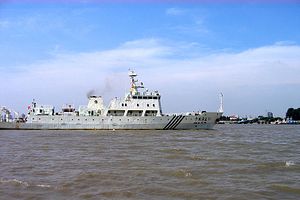It’s been a big few weeks in the South China Sea. After months of internal debate, the US finally conducted a Freedom of Navigation Operation on 27 October, sailing within 12 nautical miles of the disputed Subi and Mischief Reefs. A couple of days after the patrols the Hague’s Permanent Court of Arbitration (PCA) delivered its long awaited first verdict in The Republic of Philippines v. The People’s Republic of China, which found that the court has jurisdiction to hear the case; proceedings can now move forward to assessing the claims put forward by The Philippines. As we wait to see how things play out in the South China Sea, it’s worth taking a moment to look westward to see how India (another great and rising power in the region) has approached its maritime disputes with its smaller neighbours—and the lessons China can draw from India’s resolution tactics.
In July 2014, The Hague’s Arbitration Tribunal on the India–Bangladesh Maritime Delimitation delivered its final verdict on a 40-year-old maritime dispute between India and Bangladesh in the Bay of Bengal. The delimitation dispute began in the early 1970s when an island, named New Moore in India and South Talpatti in Bangladesh, first emerged in the mouth of the Hariabhanga River separating India and Bangladesh in the Bay of Bengal. Both India and Bangladesh laid claim to the island, leading to ongoing tensions over the maritime boundary between the two countries and the rights to the island’s Exclusive Economic Zone (EEZ) and continental shelf. After eight rounds of failed bilateral negotiations between 1974 and 2009, on 8 October 2009 Bangladesh started arbitration proceedings against India under the United Nations Convention on the Law of the Sea (UNCLOS).
The two countries’ claims were based on different interpretations of international maritime law. India’s claim to the island, which disappeared in 2011 due to rising sea levels, was based on the UNCLOS principle of equidistance, which is generally obligatorily applied in the absence of an agreement, historical titles or special circumstances. For example, Article 15 UNCLOS 1982 declares the principle valid;
Where the coasts of two States are opposite or adjacent to each other, neither of the two States is entitled, failing agreement between them to the contrary, to extend its territorial sea beyond the median line every point of which is equidistant from the nearest points on the baselines from which the breadth of the territorial seas of each of the two States is measured.
Bangladesh’s counter claim was based on the principle of equity; that if the court sided with India, Bangladesh would be left with a disproportionately small EEZ locked in by the intersecting maritime zones of India and Myanmar. The tribunal noted in its judgement that India was potentially entitled to both zones but ultimately sided with Bangladesh, breaking precedent to rule that equidistance wouldn’t lead to an equitable solution given the geographical circumstances, and awarded 19,467km of the 25,602km EEZ to Bangladesh.
That interpretation of the equity principle in Bangladesh’s favour could have led to a rapid deterioration in relations between the two countries, particularly given their long history of border tensions. But despite over 40 years of bickering, the binding verdict was embraced by India as benefiting both states by ushering in a new period of cooperation and mutual understanding. Bangladesh commended India’s willingness to resolve the conflict through peaceful means and international law, and its respect for arbitration by upholding the tribunal’s verdict. As a result of the ruling, India and Bangladesh have been able to resolve other long-standing land and border disputes.
When it comes to the South China Sea, China repeatedly stresses it wants to resolve the current disputes peacefully. New Delhi’s positive response to the 2014 Bay of Bengal ruling offers Beijing some valuable lessons they would do well to apply in the South China Sea.
First, like China vis-à-vis the Philippines, India is a much larger country than Bangladesh. At the time of the ruling, India was widely praised for not bullying its much smaller neighbour Bangladesh into a decision, declaring that even though India might have been the stronger country, they’re still subject to international law and need to abide by internationally agreed principles. As China seeks to win friends and influence states in the region, Beijing could take a leaf out of India’s book by responding to the tribunal proceedings. But by refusing to acknowledge the ongoing tribunal proceedings, China undermines the credibility of UNCLOS and the entire international legal system, something naturally alarming to its neighbours.
Second, China should take India’s lead in abiding by whatever ruling (binding under UNCLOS Article 288) the PCA hands down. Despite China’s economic and military might, if China loses the arbitration (which it’s expected to—see James Kraska’s legal analysis of the case) and ignores the ruling, the damage to China’s reputation and standing as a regional and global power would be irreversible. In this scenario, it isn’t difficult to imagine the US significantly ramping up its presence in the South China Sea and a dramatic increase in regional pressure on China to uphold the ruling.
If China’s long term strategic goal is for closer relations with its neighbours and ongoing peace in the region, China will need to follow India’s lead in the Bay of Bengal by engaging with the Philippines tribunal proceedings and abiding by the tribunal’s decision. While that won’t be easy for Beijing, China will need to evaluate whether the short-term gains in the South China Sea really serve its long-term strategic goals.
Mercedes Page is a research intern at the Australian Strategic Policy Institute (ASPI). This piece was originally published over at The Strategist, the official blog of ASPI, and is republished with kind permission.

































